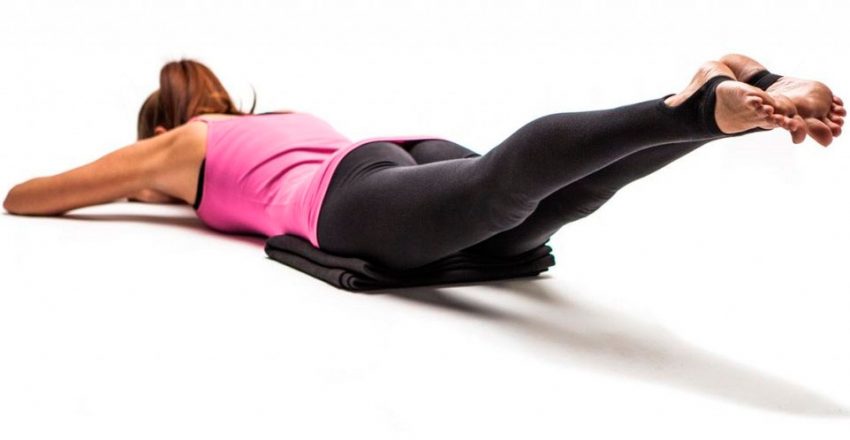This exercise is performed on the floor on a rug. It “comes” from the Pilates system. It is used to strengthen the hamstrings and buttocks. It can also be used as a gentle force for lumbar injuries. In practice, it is often included in training plans for the predominant development of the buttocks as a “finishing touch”. This movement requires thoughtful execution and conscious control of the movement.
Execution technique

Initial position
- Lie facedown on the floor on a thick rubber mat, two regular yoga mats, or 1 Pilates mat;
- Place your forehead on palms folded in front of you;
- Tighten the stomach by 30 percent, strain the upper back, remove the shoulder blades from the ears, lower them to the pelvis;
- Touch the floor with the ankle, pull the socks back.
Traffic
- Tear off the thighs from the floor due to the tension of the muscles of the buttocks;
- At the same time, strain your stomach a little harder and, as it were, press the anterior abdominal wall into yourself;
- Raise the hips to that height while the position of the lower back remains comfortable;
- Return to starting position;
- The pace of execution is slow, raising the hips for several accounts, as well as lowering.
Attention
- First, the ankle should come off the floor, and only then the hips;
- Swing is not allowed;
- The body can either be raised, coming out to rest on the forearms, or left on the floor. Each person is looking for a comfortable position based on their anthropometry.
Typical mistakes
- A sharp swing of legs, work due to inertia;
- Relaxation of the abdomen;
- Overstrain of the lower back due to too high lifting of the legs;
- Complete separation of the body from the floor, touching its surface only with the lower abdomen.
Inclusion in the training program

Such exercises are performed either at the stage of rehabilitation after an injury, when classical strength training is prohibited, or as “formative” exercises. It is also possible to include them in the programs of untrained beginners as a movement that is designed to “introduce them to sports” and strengthen muscles.
In the case of beginners, this exercise is included in a series of Pilates on the legs after the “bridges”, and alternating leg raises to the side. The exercise is performed for 10-12 repetitions in 2-3 series, if we are in front of a completely beginner athlete – one series is enough.
When working on rehabilitation, the volume and inclusion are selected individually. With injuries of the lower back and biceps of the thighs, an exercise is performed in an amount of no more than that which feels comfortable.
As a formative exercise, movement can be included in the programs of healthy people after normal strength training. Then it is performed according to the sports principle “to failure” in 2-3 approaches.
Execution variations

This exercise can be performed while lying on a straight gymnastic bench, or lying on a gymnastics bench with a reverse incline. In this case, the exercise will give more static tension in the lower back and the long back muscle, and a little more actively engages the buttocks.
There is another option in which the legs rise back in the hanging on the horizontal bar, the movement resembles this exercise, but more includes the latissimus muscles.
Contraindications
The exercise is not recommended for any injuries of the lumbar spine, hernias and protrusions in this area. You should not do it if you have pelvic inflammatory disease.
The rest of the recommendations are standard:
- After tears and tears of the biceps of the hips, some time should pass;
- Do not perform during pregnancy, throughout its duration;
- In the postpartum period, at least 12 weeks must elapse after a natural birth;
- Not recommended for ACL and ankle injuries;
- May cause pain in the hip joints, given their specific structure
The exercise, due to an uncomfortable starting position, is not intended for use with weights or for setting power records. It is better not to do it with weights, and if additional loads are needed, switch to reverse hyperextension in the simulator.
